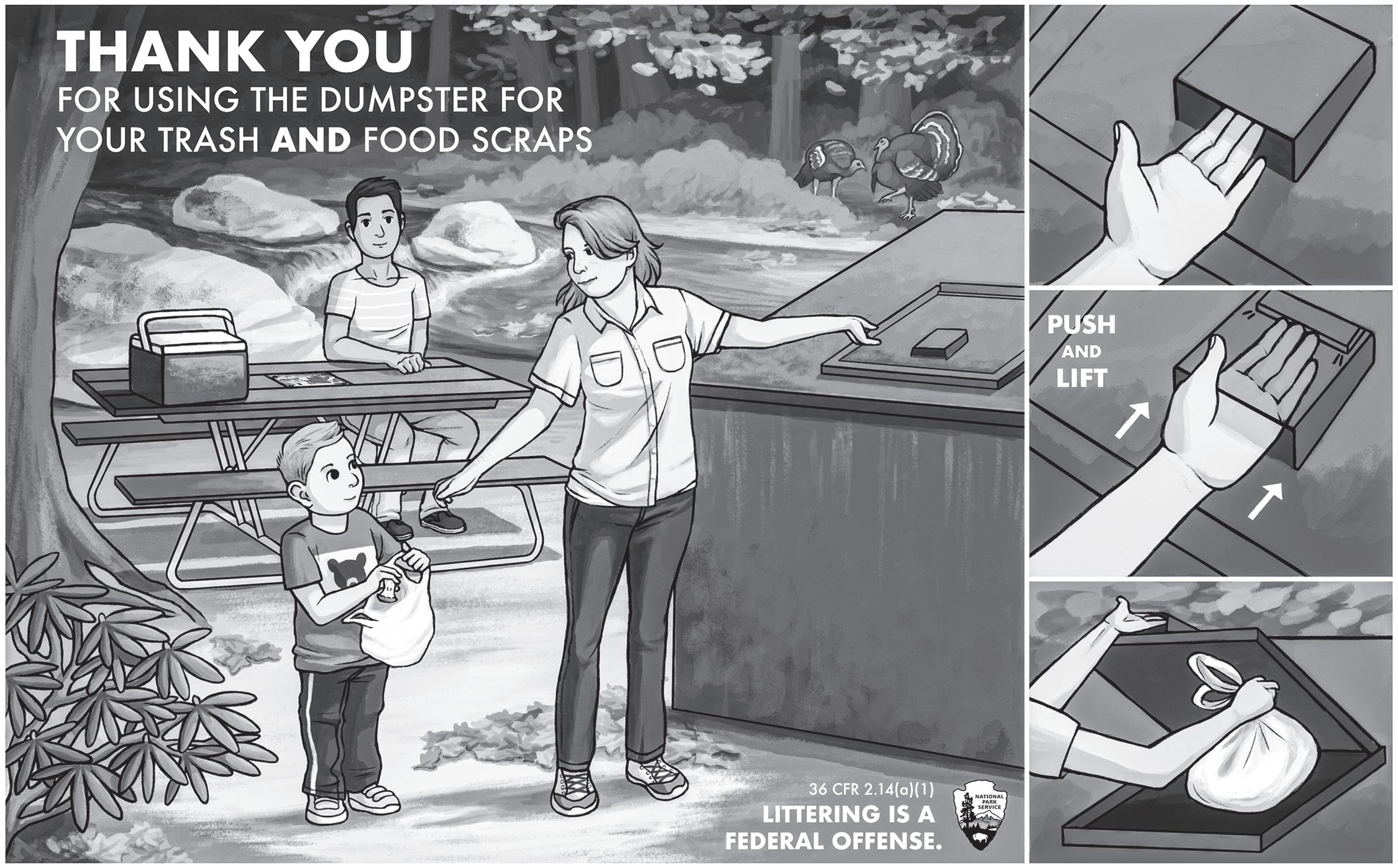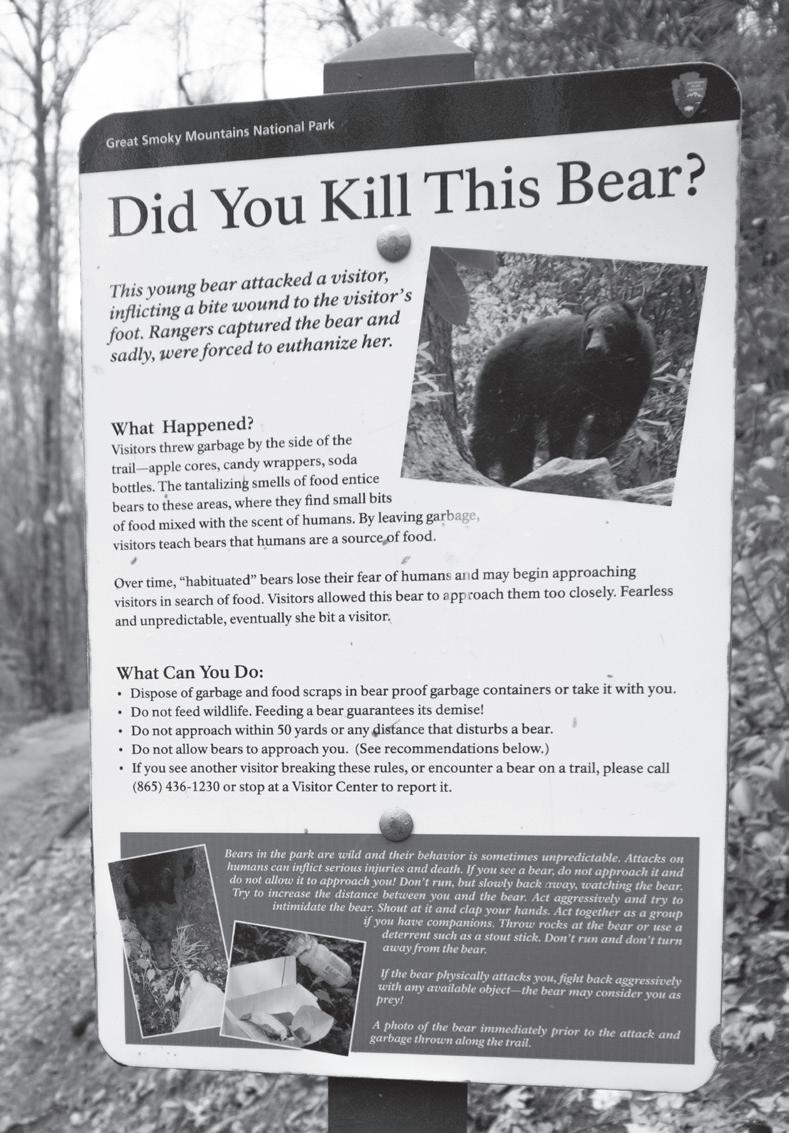
4 minute read
Park Etiquette
Littering puts strain on park services and wildlife
Supervisory Wildlife Biologist Bill Stiver has worked in Great Smoky Mountains National Park managing black bears, elk, hogs, and more for nearly 30 years. But over the last decade of his tenure, he has been forced to respond to one issue affecting Smokies wildlife with alarming regularity: trash on trails.
“Around Cades Cove, Alum Cave, Grotto Falls, Laurel Falls, Abrams Falls, Ramsey Cascades—on a lot of these shorter destination hikes, trash keeps ending up on those trails,” said Stiver. “We’re not pointing the finger at anyone so much as asking people to help us with this.”
A bear of a problem
Litter along roads and trails disrupts the natural foraging behavior of a wide variety of wildlife, but for black bears in particular, the consequences can be dire. Food-conditioned behavior cuts black bears’ life expectancy in half. “The bear may begin foraging in picnic areas or hanging out beside the road,” said Stiver. “In some cases, bears may even approach people hoping for a handout.” When this pattern begins to emerge, park service employees are forced to intervene. “Depending on the severity of the incident, we might chase a bear away with small explosives, trap the bear and relocate it, or, in extreme cases, euthanize the animal,” said Stiver. “Whichever way it goes, rangers take no pleasure implementing these aggressive management measures.”
Black bears have a remarkably keen sense of smell and the ability to topple heavy receptacles for the promise of food. Since mother bears pass on knowledge of reliable food sources to their cubs, a single source of unsecured food waste can create a cascade of negative consequences for generations. The park service has made a concerted effort to reduce the potential for conflict by repairing existing food storage cables, installing more secure dumpsters where appropriate, and regularly clearing picnic areas of trash left behind at dusk. Still, with the national park generating nearly 600 tons of waste per year, a long-term solution will have to include greater public awareness of Leave No Trace principles.

Above: You can help protect wildlife by packing out all trash and food waste and by using bear-proof dumpsters when disposing of trash in the park. When closed properly, these dumpsters keep trash where it belongs—secure and away from wildlife. Illustration by Emma DuFort. Right: Signage at popular trailheads educates visitors on the dangers of littering food waste, but it doesn’t completely stem the epidemic. Photo by Valerie Polk.
On litter patrol
“At some point you just take ownership, and it becomes personal,” said Bill Gober, a weekly volunteer and ‘rover’ on Laurel Falls Trail who picks up trash along with a small army of Litter Patrol volunteers. “When those bears roam, we want them to find nothing. If they

Sources:
“Hikers: Eat Bananas—but Take Your Skins Home,” theguardian.com; “How Long Does Your Litter Live?” slocounty.ca.gov; “‘Organic’ Litter is Not Copacetic,” hcn.org; “Recycling Mysteries: Candy Wrappers,” earth911.com; “Disposable Face Masks Are Damaging the Environment,” independent.co.uk.
Even a soft, mushy apple core can linger on the landscape for as long as 2 months. That’s more than enough time to draw wildlife to places they shouldn’t be.
Banana peels can take around 2 years to completely rot—the thick skin protects the inner fruit from the cold and resists decomposing quickly. Cigarette filters contain cellulose acetate, a form of plastic. These abundantly littered items remain intact for 5 to 10 years on average. Most candy wrappers (and granola bar wrappers) are made of a plastic and aluminum combo that won’t break down for 10 to 20 years.
Disposable face masks can take 450 years to biodegrade and are a hazard to wildlife and the volunteer litter patrols who must retrieve them.

find food, they’re coming back.” While biodegradable food waste like apple cores, banana peels, or cookie crumbs may seem harmless, these are often the very items that are the biggest offenders when it comes to attracting wildlife to trails and dangerous roadways.
Gober’s regular beat is Laurel Falls, one of the most popular trails in the park and a hotspot for human–bear conflict. “The litter is increasing with visitation—that’s to be expected—and it tends to be within the first mile of most trails,” said Gober. Even so, Gober does see hope for a change in attitudes through his contact with visitors and volunteers on the trail. “I would just encourage others to bring a bag or two with them when they go,” said Gober. “It always helps if we can keep it minimal, and maybe more folks will think twice next time.”
You can help protect wildlife by packing out all trash and food waste while in the park. Check out the BearWise® basics at bearwise.org or go to nps.gov/grsm/getinvolved to lend a hand with other volunteers in the Litter Patrol program. While biodegradable food waste like apple cores, banana peels, or cookie crumbs may seem harmless, these are often the very items that are the biggest offenders when it comes to attracting wildlife to trails and dangerous roadways.








